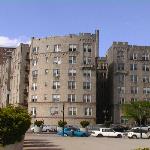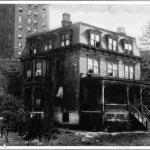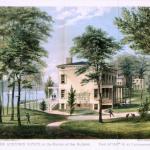The old house...will be lifted sixty feet to the level of the viaduct... and then rolled to its permanent site...
New York Times
November 11, 1931
The plan of a civic committee to save the old Audubon homestead ...seemed endangered yesterday when it was revealed... that Henry Brandt...had threatened to withdraw the offer to sell the house...
New York Times
November 11, 1931
Reginald Pelham Bolton...said yesterday that the house would be demolished. "We can't do a thing to stop it," Mr. Bolton said...
New York Times
November 22, 1931
Wreckers began yesterday to raze the John James Audubon house at 155th and Riverside Drive...
New York Times
December 2, 1931
The house in which John James Audubon...spent his last years is to be saved to posterity after having been abandoned to the wreckers, it was announced yesterday by Harold W. Decker, an ornithologist of the Bronx.
New York Times
December 6, 1931
Reconstruction of the old home of John James Audubon...upon a permanent park site at Riverside Drive and 161st Street, was begun yesterday...
New York Times
December 9, 1931
The Audubon Houses (Minnies Land)
Across Riverside Drive, the building with a curved front and crenellated roof-line that resembles a battlement is 765 Riverside Drive. Opening in November 1932, it occupies the site of the Audubon house, which sat some fifty feet below the present street level. (You might want to look down into the cemetery again to envision that depth.) The Audubon house was a two-story structure with an English basement. Broad piazzas ran across the second floor at the front and the back. Later owners “improved” it with a mansard roof and bay window. Samuel Morse, a friend of Audubon’s, may have sent the first telegraph message across the Hudson from a laundry in the basement. In the 1840s, Audubon’s two sons, Victor and John Woodhouse, built their own houses along the river just north of here. The Audubon property included outbuildings and a barn where unsold copies of the folio edition of The Birds of America were stored. Although the Audubons refer to their entire estate as Minnies Land, with time and with the adoption of “Audubon Park” for this area, the name "Minnies Land" became associated with the original house only.
When the George Washington Bridge opened in October 1931, the ninety-year-old Minnies Land still sat on its original site, with the Riverside Drive retaining wall at its back. The city had already condemned the property in the mid ‘20s and the house was scheduled for demolition. For more than a decade, individuals and community groups had been lobbying to save the Audubon house, but to no avail. In November 1931, workmen began dismantling the Mansard roof and bay window. At the last minute, Harold W. Decker, an ornithologist, came forward with funds to move the house to a plot of land that the city had donated at Riverside Drive and 161st Street. Decker, working with the Audubon Society, intended to restore the house and convert it to a museum.
By early December, the house, sliced into pieces, was on its new site and fund-raising efforts were underway for its restoration. Then the paper trail disappeared, as did the house. Most likely, it sat decaying while Decker attempted to raise the restoration funds, eventually succumbing to the elements, looters, and the scrap heap. Its removal and disappearance marked the symbolic end of Audubon Park, though use of that name had already begun to wane.
765 Riverside Drive opened in 1932, barely a year after the Audubon house’s removal. The architect was Albert E. Schaeffer; his associate, Harry B. Rutkins. The crenellated roof line and the piers that extend above it, lend this six-story building the aura of a castle. As you can see, the façade is split into three sections with the outer two curved to fit gracefully into the path of Riverside Drive. What you can not see is that this building sits on steel piles that run forty-five feet below the curb level and then another forty feet down to bedrock. In November 1932, the New York Times reported that the foundation alone contained over 1,600 tons of steel. The space below, once Audubon's lawn, is now used as a series of garages, where Riverside Drive’s stone retaining wall is still visible.
 | ||||
 | ||||
765 Riverside Drive
(click to enlarge)
 | ||||
Idealized Image of Minnie's Land
(click to enlarge)
Minnie's Land: Circa 1928
(click to enlarge)
Continue your walk . . .
Funded by the Audubon Park Alliance


